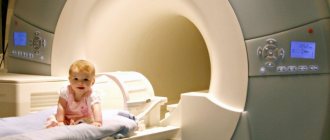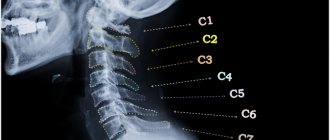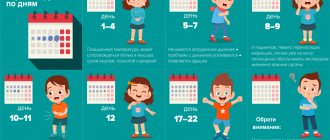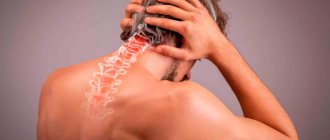Causes of severe headaches
An attack of sudden pain in the head can be associated with disorders of the cardiovascular system, endocrine glands, as well as various diseases of other organs. It is impossible to conduct a complete diagnosis at home, but it is important to pay attention to the characteristics of the headache. The location of its manifestation, strength and other characteristics may indicate the reason why it occurs.
- Severe, acute pain in the head is a consequence of traumatic brain injury, infectious diseases of the brain. They can also be a sign of migraine, hypertension and other diseases. If the pain continues to intensify, this indicates an increase in inflammatory or degenerative processes.
- Prolonged pain indicates dangerous chronic processes that require timely treatment. During diagnosis, a person may be diagnosed with infectious diseases of the brain, neoplasms, and parasite infestations. You should consult a doctor if attacks occur frequently and last more than a day.
- Throbbing pain is a typical symptom of hypertension or increased intracranial pressure. However, similar symptoms manifest themselves in migraine, eye and inner ear diseases. To understand the exact cause, a diagnosis must be carried out.
- Sudden, sharp pain accompanies vascular spasms. It can also occur due to mechanical compression of the nerve (with osteochondrosis and other diseases of the spine). However, a similar picture can develop with a stroke, so it is important to seek medical help in time.
Headache is not a separate disease, but a signal from the body about various disorders. A person needs to recognize it in time and begin treatment, depending on the cause. It is also important to understand the mechanisms of how pain occurs in order to select the most effective drugs against it.
Migraine
Migraine is a primary headache and one of the most common types. It often affects only one half of the head, but can also spread to the entire circumference of the head. It is believed that migraine attacks are associated with vascular or neurogenic disorders, and the triggers are environmental factors. A typical migraine occurs in several stages. Patients who have suffered from this disease for a long time can recognize the onset of an attack in the early stages and take anti-migraine medication in time.
- Prodromal phase - can begin several hours or days before an acute attack of headache. It is manifested by minor changes in well-being and mood swings. Disorders of the digestive tract and muscle spasms in the neck may also occur.
- Aura is a neurological symptom that develops in most patients. It begins immediately before a headache attack and lasts no more than an hour. Visual disturbances appear more often, which consist of a decrease in the ability to concentrate on various objects, the appearance of dark spots and circles in the field of vision. Sensory disturbances (tingling sensations, numbness of the skin), dizziness, speech impairment and memory loss are also possible. These symptoms are temporary and go away after the attack.
- The headache itself – in an adult, on average lasts from 4 hours to 3 days. For children it lasts no more than an hour. The pain can be unilateral or bilateral, often accompanied by soreness and discomfort in the neck. Patients also often complain of nausea, dizziness, and loss of coordination.
- Postdromal phase – develops after an intense headache. For some time after the attack (several days), disturbances such as fatigue, nausea, confusion, mood swings, and gastrointestinal disorders may remain.
Migraine is a chronic disease that can occur for the first time in both children and adults. Attacks occur with varying frequencies - from once every few years to several times a week. Headaches can be triggered by stress, extreme fatigue, and sudden changes in weather conditions. It is intense, and conventional painkillers are ineffective against it. The doctor will prescribe special medications against migraines, which must be taken at the first manifestations of the disease.
Read more in the material : Migraine with aura
Vascular disorders
Most cases of severe headaches are associated with changes in blood pressure (see Headache due to hypertension). Hypertension is a common disease that occurs in older people, as well as in various vascular pathologies. It can be triggered by atherosclerosis, a chronic disorder in which the walls of the arteries become saturated with cholesterol and certain fractions of lipoproteins. Their deposits narrow the lumen of blood vessels and can form plaques. Also, hypertension is often caused by decreased elasticity of the arteries, excess weight, and abnormal physical activity. It manifests itself in attacks during which the patient experiences the following symptoms:
- attack of severe headache;
- redness of the facial skin and visible mucous membranes;
- a feeling of pulsation in the head, which is especially noticeable in the back of the head and temples;
- increased heart rate;
- general weakness and dizziness;
- deterioration of hearing and vision, the appearance of visual, auditory, sensory hallucinations;
- disruption of the digestive tract.
Some patients are diagnosed with chronic hypotension. It is associated with a decrease in blood pressure. Attacks are manifested by a sharp, aching headache, impaired coordination of movements. A sudden drop in blood pressure may cause fainting. You can measure your blood pressure yourself using a tonometer. Its constant decrease is dangerous, since tissues experience hypoxia (oxygen starvation), which leads to disruption of their function.
Stroke
A stroke is an acute disorder of cerebral circulation. It can occur during prolonged ischemia or due to hemorrhage in the brain tissue. There are two main types of stroke. The first of them is ischemic, associated with insufficient blood supply to the brain. It can occur with prolonged hypotension or with narrowing of the lumen of important vessels. The second type is hemorrhagic, which is a cerebral hemorrhage. It can manifest itself in cases of traumatic brain injury or due to rupture of a vessel due to hypertension. The second type is more dangerous because it is more often fatal.
A stroke is manifested by a severe headache, nausea, and pallor of the mucous membranes. Fainting often occurs, but in some cases the person remains conscious. There is a diagram of how to identify the signs of a stroke in the early stages:
- ask the person to smile - the smile may be asymmetrical due to the inability to raise one of the corners of the mouth;
- raise both arms in front of you - one of them cannot be raised to the same height;
- repeat a simple sentence - during a stroke, diction is impaired, a person is unable to produce some words.
It is useful for every person to know the first signs of a stroke. The effectiveness of medical care decreases within a few hours. Even a mild attack can lead to irreversible changes in the structure of the brain, necrosis of its individual areas. Timely emergency care is the only way to restore cerebral circulation. This is followed by a long period of rehabilitation, the effectiveness of which depends on many factors: the severity of the attack, the age of the patient, and the presence of concomitant diseases.
Sinus pain
Colds can be complicated by inflammation of the paranasal sinuses. These formations are cavities in the skull filled with air. Inside, they are covered with a thin mucous membrane, on which viruses and bacteria develop during various infectious diseases. There are several types of sinusitis, which are manifested by a sharp headache:
- sinusitis - inflammation of the paranasal (maxillary) sinuses;
- frontal sinusitis - infection of the frontal sinus;
- ethmoiditis - inflammation of the sphenoid sinuses;
- sphenoiditis - inflammation of the mucous membrane of the ethmoid bone sinuses.
The most common type of sinusitis is sinusitis . It manifests itself in adults and children and often occurs in a chronic form. Characteristic signs of this disease are nasal congestion, fever, frequent headaches and general deterioration in health. Often these symptoms worsen in the cold and are practically not felt in a warm room. The simplest test for sinusitis can be done at home - sharply tilt your head forward and down. With sinusitis, this movement is accompanied by a sharp headache. To treat sinusitis, a course of antibiotics, nasal rinsing and symptomatic medications are prescribed. If these methods are not effective enough, it may be necessary to puncture the maxillary sinus to remove its contents and rinse the cavity with an antibacterial solution.
Read more: Sinus headaches
Infectious diseases
Influenza, acute respiratory viral infections and other viral respiratory diseases in the initial stages can manifest as a sharp pain in the head. They occur when an infection enters the mucous membranes of the mouth and nose, after which it causes acute inflammatory processes in the respiratory organs and nasopharynx. Viruses and bacteria are constantly in the external environment, and a person comes into contact with them, but infection occurs when the body’s immune defense is reduced. This is manifested by the following symptoms:
- headache, which may be the first of all symptoms;
- nasal congestion, runny nose;
- sore throat, inflammation of the mucous membrane of the nasopharynx;
- cough, pain when breathing.
A dangerous infectious disease that is accompanied by a severe headache is meningitis. It is manifested by inflammation of the membranes of the brain and poses a danger to the patient’s life. Its main cause is a viral and bacterial infection that penetrates the brain during various infectious diseases. Meningitis is manifested by acute headaches, nausea and vomiting, impaired coordination of movements, deterioration of hearing and vision, and fainting is also possible. Treatment takes place in a hospital setting, under the constant supervision of doctors.
Neuritis
Acute headaches can be caused by damage to the trigeminal nerve. This is the largest of the cranial nerves, which along its length is divided into 3 parts. Its mechanical damage or infectious inflammation causes acute, throbbing pain. It can appear in the forehead and temples, nose and upper jaw, or resemble a toothache. Headache with trigeminal neuritis is also accompanied by additional symptoms:
- spasms of the muscles of the face and head;
- increased body temperature;
- decreased sensitivity of facial skin;
- deterioration in the mobility of facial muscles.
At the first signs of neuritis of the facial nerve, it is necessary to begin treatment. The doctor will select a set of drugs that will affect both the cause and symptoms of inflammation. The general regimen includes antibiotics, anti-inflammatory and painkillers.
Other reasons
A sharp headache can also occur in a healthy person. Its causes include physical fatigue, stress, nervous tension, and disruption of sleep schedules. However, if it does not go away for a long time or appears too often, you should consult a doctor for a full examination. As a result, the following diseases are detected:
- injuries and their consequences - painful sensations can manifest themselves for a long time after a head injury;
- increased intracranial pressure;
- inner ear diseases;
- Cluster pain is a rare type that is characterized by very high intensity.
Regardless of the cause of the headache, it is dangerous to endure this condition. Your home medicine cabinet should contain painkillers that will relieve an attack. If pain is not relieved, brain cells experience constant hypoxia, which further increases the risk of stroke.
Other reasons
Headache can be caused by other reasons:
- hormonal changes in the body during pregnancy, with the onset of menopause,
- some diseases of the endocrine system - hyperthyroidism, diabetes mellitus, dysfunction of the adrenal glands;
- acute respiratory diseases;
- sinusitis, otitis, sinusitis, tonsillitis;
- traumatic brain injury, concussion;
- infectious lesions;
- chronic inflammatory processes in the body.
Headache, pills and chewing gum
Sometimes a headache can occur due to a completely unexpected reason. For example, headaches that occur while taking certain painkillers are called headaches.
An interesting study was conducted by Israeli scientists. They found that young people and teenagers who constantly chew gum often experience headaches. This is due to tension in the temporomandibular system due to continuous load during chewing movements.
Such a variety of causes of headache requires special attention to the nature of the sensations, the localization of the source of pain, and its intensity. A symptom checker can sometimes reveal more about the source of the problem.
However, only a thorough history taking and a comprehensive examination will help establish the correct diagnosis and determine treatment tactics.
Diagnostic methods
To choose an effective headache treatment regimen, it is important to undergo a full examination and determine its cause. To do this, a set of tests is prescribed to assess the condition of the heart and blood vessels, brain and other organs. It may include the following techniques:
- General and clinical blood tests - allow you to identify inflammatory processes, acute and chronic diseases of internal organs;
- electroencephalography is a method for diagnosing the brain, thanks to which it is possible to detect signs of tumors and vascular pathologies;
- MRI is an informative technique for assessing the patient’s condition in case of stroke, sinusitis, trauma and other pathologies;
- Ultrasound of the vessels of the neck and head using a contrast agent (Dopplerography) - allows you to determine atherosclerosis and other vascular diseases.
The Clinical Institute of the Brain has all the conditions for accurate and comfortable diagnosis. Doctors have extensive experience in treating diseases that are accompanied by severe headaches. They will prescribe only the necessary examinations to quickly determine the cause of the pain and prescribe an effective treatment regimen.
Different types of headaches
Doctors identify more than 250 types of headaches, but some of them are more common than others (Fig. 3).
Figure 3. Common types of headaches. Source: MedPortal
Tension
Tension or tension headaches are the responsibility of a neurologist. This is the most common and varied type of pain. It can cover just one area, such as the forehead or back of the head, or spread over the entire head (Fig. 4).
Figure 4. Tension headache. Source: MedPortal
According to subjective sensations, tension pain resembles compression of the skull and muscle tension. People who spend a lot of time at the computer, lead a sedentary lifestyle, truck drivers, seamstresses, and office workers are most prone to tension pain.
You can get rid of periodic tension pains by changing your lifestyle and including mandatory walks in the fresh air and gymnastics in your daily routine. You should also avoid stressful situations and excessive physical activity if possible.
Post-traumatic
Pain can appear not only after a head blow, but also after any spinal injury, and not immediately after it, but after several weeks or months.
Special treatment for such headaches is not required; the condition can improve after general restorative procedures prescribed to eliminate the consequences of injury: gymnastics, massage, normalization of sleep and diet.
Migraine
Migraine is one of the most intense headaches, usually affecting half of the skull (Fig. 5). An attack can be triggered by certain foods, stress, an irritant in the form of an unpleasant or simply concentrated odor, or a bright flashing light.
Figure 5. Pattern of pain in migraine. Source: MedPortal
Migraine is often accompanied by nausea, dizziness, and general weakness. It mainly affects middle-aged women. There is no single method of treating migraines, but your doctor will help you choose medications that relieve unpleasant symptoms.
Migraine aura
About 25% of people suffering from migraines see black dots or bright lines in front of their eyes, hear extraneous noises, or smell an intrusive odor before attacks of pain. It's all an aura, and it usually ends when the pain begins. Another possible companion to migraine is Alice in Wonderland syndrome, when a person is unable to adequately perceive his own size in space.
Sinus
Most often, such pain is associated with inflammation of the nasal sinuses, so they are localized in the area of the bridge of the nose or forehead (Fig. 6). The pain is very severe and occurs against a background of difficulty breathing, nasal congestion, fever, and swelling. Antihistamines (if the cause of nasal congestion is an allergy) or antibiotics prescribed by a doctor can help get rid of such pain.
Figure 6. Characteristics of sinus headaches. Source: MedPortal
Cluster
Such intense acute pains are mainly characteristic of men and are difficult to treat. The attacks can be short-lived, but sometimes last a day or more. The pain is pulsating in nature, usually localized in the eye area, accompanied by swelling of the nasal mucosa and lacrimation.
Infectious
Almost all infectious diseases are accompanied by headaches of varying nature and intensity. The pain goes away after successful treatment of the underlying pathology.
Hypertensive
An increase in blood pressure is often accompanied by a nagging pain in the occipital region. This is especially true for older people. After taking antihypertensive drugs and normalizing the condition, the pain goes away, however, it can appear with a sharp decrease in pressure.
Hormonal
Headache due to changes in hormonal levels is familiar to most women before the onset of menstruation. Similar pain occurs in women in the early stages of pregnancy and during menopause. Most often, discomfort is felt in the upper part of the head and temples. Menopausal pain can be relieved by selecting compensatory therapy from a specialist.
Tumor
As the tumor grows in the brain, the pain intensifies. Usually the attack begins in the morning and is accompanied by nausea and dizziness. The symptoms in this case are relieved with painkillers, the pain goes away after defeating the tumor.
Caused by intracranial bleeding
When a vessel ruptures, pain appears suddenly and is usually accompanied by vision problems, slurred speech, and loss of orientation. Such symptoms require urgent medical attention.
Related to trigeminal nerve injury
The trigeminal nerve hurts in sharp, pulsating short attacks, the pain covers the entire head or only the face area. Anticonvulsants and physiotherapeutic procedures are prescribed to relieve pain.
Cervicogenic headache
The pain is associated with problems in the cervical spine and is usually localized only on one side. Pain can occur when you move your head suddenly or when you change body position. Complex therapy includes muscle relaxants, nonsteroidal anti-inflammatory drugs, and anticonvulsants.
Headache treatment
To treat a headache, it is important to determine its cause. At home, you can take a pain reliever and massage your neck and head. However, the doctor prescribes the full regimen based on test results. It may include the following techniques:
- drug treatment (antibiotic therapy for infectious processes, muscle relaxants, anti-inflammatory drugs, drugs to improve blood supply to the brain);
- physiotherapy – a set of techniques based on the effects of ultrasound, heat, electric or magnetic field;
- physical therapy – prescribed for neck diseases that are accompanied by headaches.
Doctors at the Clinical Institute of the Brain recommend not to self-medicate. Modern techniques allow you to quickly and safely get rid of headaches, eliminate its causes and prevent further development of diseases. The doctor will prescribe an effective regimen, but the results of treatment largely depend on following all instructions at home.
Treatment
Conservative therapy
The treatment plan is drawn up taking into account the cause of pain:
- Tension headaches
. To normalize the psycho-emotional state and restore muscle function, antidepressants, muscle relaxants, and NSAIDs are used. An occipital nerve block is performed. Relaxation therapy, biofeedback and acupuncture sessions are carried out. - Vascular pathologies
. For arterial hypertension and atherosclerosis, antihypertensive and lipid-lowering drugs, beta-blockers, diuretics, and antiplatelet agents are indicated. Arterial hypotension and VSD are corrected by hydrotherapy, massage, acupuncture, aromatherapy, medicinal electrophoresis, prescribing adaptogens, vitamins, antioxidants, tranquilizers, and antidepressants. - Inflammatory diseases of the central nervous system
. When treating acute bacterial inflammation, massive antibiotic therapy is necessary. For viral etiology of the disease, symptomatic and restorative drugs are used. For arachnoiditis, glucocorticosteroids, antiepileptic, antiallergic, and dehydration agents are prescribed. - TBI
. Therapeutic tactics are determined by the type and severity of the injury. Nootropics, neurometabolites, and anti-inflammatory drugs are effective. For open injuries and infectious complications, antibiotics are required. In severe cases, infusion therapy is carried out, and measures are taken to maintain vital functions. - General infections and intoxications
. In case of infectious pathologies, it may be necessary to eliminate the pathogen, and in case of intoxication, the use of antidotes. The detoxification program is determined by clinical symptoms. In mild cases, drinking plenty of fluids is sufficient; in severe cases, infusions of colloid and crystalloid solutions and stimulation of diuresis are carried out.
Surgery
The following surgical interventions can be performed:
- removal and evacuation of intracranial, subdural, epidural hematomas;
- separation of adhesions during arachnoiditis;
- restoration of cerebral circulation by anastomosis, reconstruction of arteries, endarterectomy.
Patients with hydrocephalus, which cannot be eliminated by other conservative and surgical methods, undergo cystoperitoneal, ventriculoperitoneal or lumboperitoneal shunting. Endoscopic ventriculocisternostomy and external ventricular drainage are performed.
Prevention methods
Sharp pain in the head is a symptom of a number of disorders, which are often acquired. This means that they are easy to prevent if you follow the recommendations of doctors:
- give up bad habits - they form toxins that adversely affect brain cells;
- exclude from the diet fatty foods, sweets, salt and spices in large quantities, fast food;
- carry out moderate physical activity - it is important to maintain muscle tone to prevent diseases of the cervical spine;
- normalize your sleep schedule.
The Clinical Brain Institute specializes in the diagnosis and treatment of diseases that manifest as severe headaches. Our center has modern equipment for conducting complex examinations, and our doctors have extensive experience in treating head pain. For most patients, it is enough to follow the recommendations at home, but the center offers the possibility of comfortable placement in a hospital.
Clinical Brain Institute Rating: 3/5 — 1 votes
Share article on social networks
Arsenal of treatment
Any headache should be a reason to consult a doctor, so as not to miss the pathology of the nervous system or internal organs, which is signaled by a headache.
The causes of headaches are established after undergoing a comprehensive neurological examination: ECHO-encephalography, electroencephalography, Doppler ultrasound of the vessels of the head and neck, rheoencephalography, radiography of the skull, magnetic resonance and computed tomography of the brain, fundus examination, consultations with the necessary specialists, laboratory methods for testing blood and urine. An integrated approach to treatment is required depending on the identified cause of the headache. In each specific case, treatment is selected individually and includes both relief of headache attacks and treatment in the inter-attack period. The doctor’s arsenal includes medicinal techniques, acupuncture, psychotherapy, autogenic training, manual therapy (especially to relieve muscle tension during tension headaches), biofeedback, massage, physical therapy, physiotherapeutic treatment, millimeter resonance therapy, laser therapy, homeopathic approaches. Thus, the variety of causes of headaches identified during a comprehensive examination also determines individual approaches to the treatment of each individual patient in the clinic of modern medicine, where the entire arsenal of diagnostic and therapeutic assistance for headaches is available.







